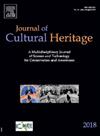A deep learning approach for cultural heritage building classification using transfer learning and data augmentation
IF 3.3
2区 综合性期刊
0 ARCHAEOLOGY
引用次数: 0
Abstract
The detection of architectural components in historic buildings is essential for digital documentation and the conservation process of cultural heritage. In this regard, recent studies have explored artificial intelligence with computer vision to enhance the detection of key components in monuments. However, this field of research still lacks investigation into the influence of using transfer learning and data augmentation to improve the performance of machine learning models. Moreover, the literature still requires research on Artificial Intelligence applied to Brazilian colonial architecture. Thus, this study proposes a new deep learning approach for cultural heritage building classification using transfer learning and data augmentation. For this purpose, the ImageMG dataset is proposed, containing 6449 images of 94 historic buildings from the state of Minas Gerais (Brazil), categorized into five classes: fronton, church, door, window, and tower. Additionally, the influence of using transfer learning to enhance the classification results of the Mobilenet architecture in the task of detecting components of historic buildings is evaluated. The proposed approach also investigates the effects of 64 combinations of data augmentation, utilizing six geometric transformations (zoom, width shift range, height shift range, vertical flip, horizontal flip, and rotation) for generating synthetic images to train the deep learning models. The results showed that the optimization of transfer learning in conjunction with data augmentation demonstrated significant advances in the performance of cultural heritage building classification. Experiments with the ImageMG dataset using transfer learning and vertical flip achieved the best accuracy results in validation (92.37 %), test 1 (90.22 %), and test 2 (87.33 %).

基于迁移学习和数据增强的文化遗产建筑分类深度学习方法
历史建筑中建筑构件的检测对于数字文献和文化遗产保护过程至关重要。在这方面,最近的研究已经探索了使用计算机视觉的人工智能来增强对古迹关键成分的检测。然而,这一领域的研究仍然缺乏对使用迁移学习和数据增强来提高机器学习模型性能的影响的研究。此外,文献仍然需要研究人工智能在巴西殖民建筑中的应用。因此,本研究提出了一种新的基于迁移学习和数据增强的文化遗产建筑分类深度学习方法。为此,我们提出了ImageMG数据集,其中包含来自米纳斯吉拉斯州(巴西)的94个历史建筑的6449幅图像,分为五类:前门、教堂、门、窗和塔楼。此外,在历史建筑构件检测任务中,还评估了使用迁移学习增强Mobilenet建筑分类结果的影响。该方法还研究了64种数据增强组合的效果,利用六种几何变换(缩放、宽度移位范围、高度移位范围、垂直翻转、水平翻转和旋转)生成合成图像来训练深度学习模型。结果表明,迁移学习优化与数据增强相结合,在文化遗产建筑分类中表现出显著的进步。在ImageMG数据集上使用迁移学习和垂直翻转的实验在验证(92.37%)、测试1(90.22%)和测试2(87.33%)中获得了最好的准确率结果。
本文章由计算机程序翻译,如有差异,请以英文原文为准。
求助全文
约1分钟内获得全文
求助全文
来源期刊

Journal of Cultural Heritage
综合性期刊-材料科学:综合
CiteScore
6.80
自引率
9.70%
发文量
166
审稿时长
52 days
期刊介绍:
The Journal of Cultural Heritage publishes original papers which comprise previously unpublished data and present innovative methods concerning all aspects of science and technology of cultural heritage as well as interpretation and theoretical issues related to preservation.
 求助内容:
求助内容: 应助结果提醒方式:
应助结果提醒方式:


